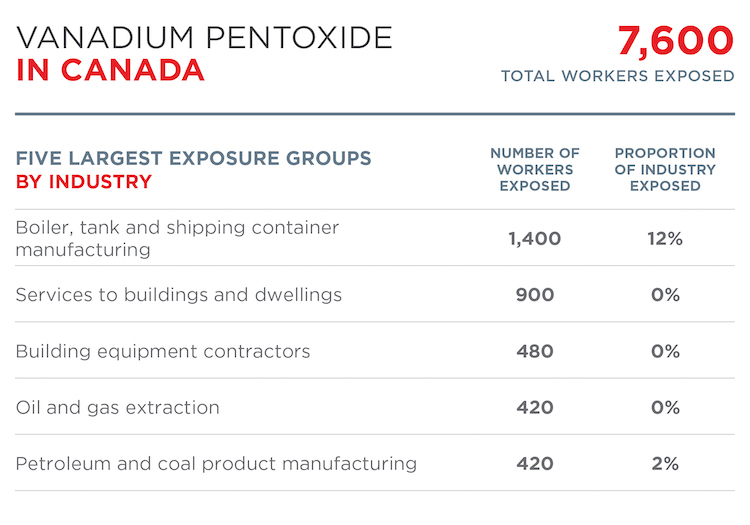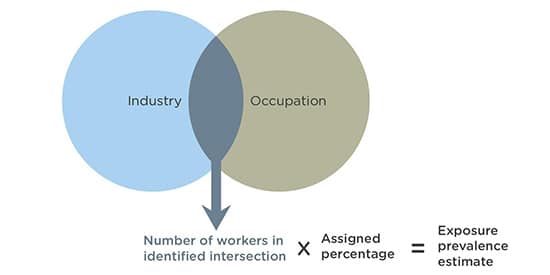Vanadium Pentoxide Occupational Exposures
Vanadium Pentoxide Occupational Exposures
Overview
Inhalation is the most important route of occupational exposure to vanadium pentoxide.[1]
CAREX Canada estimates that approximately 7,600 Canadians are exposed to vanadium pentoxide in their workplaces.
READ MORE...
The largest industrial groups exposed include fabricated metal products, boiler, tank and shipping container manufacturing, services to buildings and dwellings, and building equipment contractors. The largest occupational groups exposed to vanadium pentoxide are boilermakers, followed by welders, specialized cleaners, and other labourers in processing, manufacturing, and utilities.
Other occupations that may be exposed to vanadium pentoxide are specialized cleaners, industrial mechanics, artisans and craftspersons, petroleum refiners, and ceramicists (where vanadium is used as a pigment).[2]
Prevalence Estimate
Results show that 7,600 Canadians are exposed to vanadium pentoxide in their workplaces; 93% of these workers are male. Industries with the greatest numbers of exposed workers are fabricated metal products, boiler, tank and shipping container manufacturing, services to buildings and dwellings, and building equipment contractors.
When exposure is examined by occupation, boilermakers and welders are groups with greatest number of workers exposed to vanadium pentoxide (3,800 and 1,000 exposed, respectively). Exposure during welding activities, however, is expected to be low. Other important jobs are specialized cleaners (this represents people who are contract cleaners for boilers and flues) and other labourers in processing, manufacturing and utilities.
The number of workers exposed to vanadium pentoxide increased by approximately 430 workers from 2006 to 2016 (a 6% increase). This was driven by an increase in the total number of workers in administrative and support and waste management and remediation services, and construction.
Workers exposed to vanadium pentoxide by industry in 2016

Workers exposed to vanadium pentoxide by region in 2016
Click the second tab to view total number of workers exposed.
* = < 50 workers
Methods and Data
Our Occupational Approach page outlines the general approach used to calculate prevalence and exposure level estimates for workplace exposures.
Data Sources
Data used in developing the occupational estimates for vanadium pentoxide were collected from several sources:
- The Canadian Workplace Exposure Database (CWED) contains approximately 600 measurements for vanadium pentoxide exposure. These measurements were collected during the years 1981 to 2004 in Ontario and British Columbia workplaces.
- Canadian and US scientific peer reviewed publications that addressed vanadium pentoxide exposure in Canada and the United States.
- Grey literature including technical reports from governments and international bodies.
Prevalence Estimate Method
CAREX defines exposure to vanadium pentoxide as inhalation or dermal exposure to the compound above levels encountered in the general environment.
To determine the number of workers potentially exposed to vanadium pentoxide at work, CAREX occupational exposure experts used methods previously established in other peer-reviewed CAREX projects in Europe. A series of steps were taken to assign exposure proportions to occupations and industries at risk of exposure to vanadium pentoxide.

- Occupations and industries at risk of possible exposure to vanadium pentoxide were identified using any combination of data sources described above.
- The total number of workers in each identified occupation and industry intersection was obtained from Statistics Canada 2016 census data.
- A percentage of workers exposed was assigned to that occupation and industry intersection. Percentages were determined by consultation with existing evidence in the data sources, previously established methods from the Europe CAREX estimates and the expert judgement of CAREX occupational hygienists.
- The number of workers in the identified group is multiplied by the assigned percentage to calculate the prevalence estimate of workers exposed to vanadium pentoxide.
Sources
Subscribe to our newsletters
The CAREX Canada team offers two regular newsletters: the biannual e-Bulletin summarizing information on upcoming webinars, new publications, and updates to estimates and tools; and the monthly Carcinogens in the News, a digest of media articles, government reports, and academic literature related to the carcinogens we’ve classified as important for surveillance in Canada. Sign up for one or both of these newsletters below.
CAREX Canada
School of Population and Public Health
University of British Columbia
Vancouver Campus
370A - 2206 East Mall
Vancouver, BC V6T 1Z3
CANADA
As a national organization, our work extends across borders into many Indigenous lands throughout Canada. We gratefully acknowledge that our host institution, the University of British Columbia Point Grey campus, is located on the traditional, ancestral, and unceded territories of the xʷməθkʷəy̓əm (Musqueam) people.



